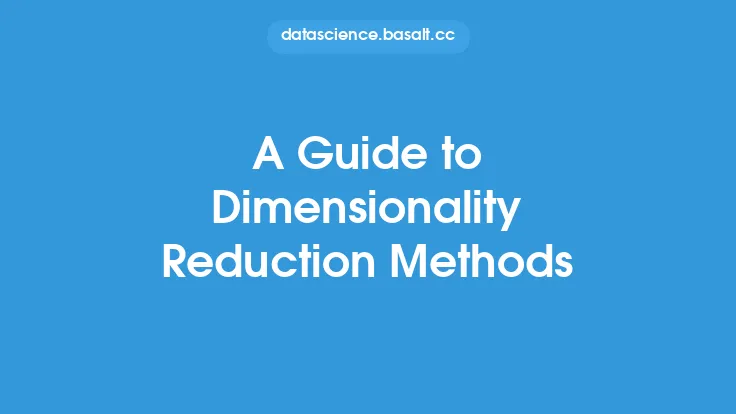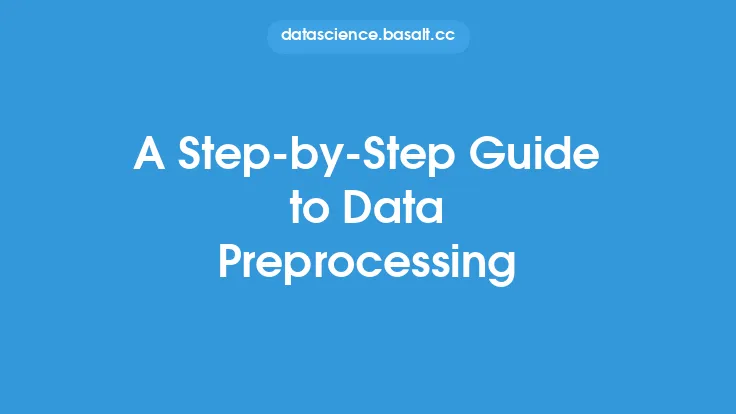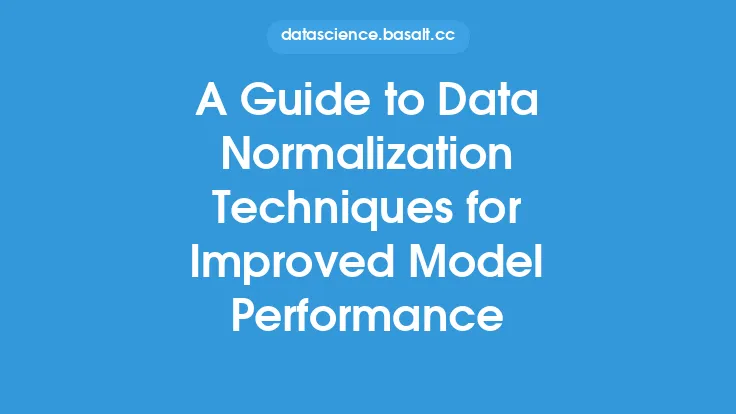Dimensionality reduction is a crucial step in data analysis, as it enables the transformation of high-dimensional data into a lower-dimensional representation, making it easier to visualize, analyze, and process. High-dimensional data can be challenging to work with, as it can lead to the curse of dimensionality, where the number of features exceeds the number of samples, resulting in overfitting and poor model performance. Dimensionality reduction techniques aim to reduce the number of features in a dataset while preserving the most important information, thereby improving model performance, reducing noise, and enhancing data interpretation.
Introduction to Dimensionality Reduction
Dimensionality reduction techniques can be broadly categorized into two types: feature selection and feature extraction. Feature selection involves selecting a subset of the most relevant features from the original dataset, whereas feature extraction involves transforming the original features into a new set of features that capture the most important information. Both techniques have their advantages and disadvantages, and the choice of technique depends on the specific problem and dataset. Feature selection is useful when the number of features is relatively small, and the goal is to identify the most relevant features. Feature extraction, on the other hand, is useful when the number of features is large, and the goal is to reduce the dimensionality of the data while preserving the most important information.
Types of Dimensionality Reduction Techniques
There are several dimensionality reduction techniques, each with its strengths and weaknesses. Some of the most common techniques include:
- Principal Component Analysis (PCA): PCA is a widely used technique that transforms the original features into a new set of features called principal components. The principal components are ordered by their variance, and the first few components capture the most important information in the data.
- Singular Value Decomposition (SVD): SVD is a factorization technique that decomposes a matrix into three matrices: U, Σ, and V. The U and V matrices represent the left and right singular vectors, respectively, and the Σ matrix represents the singular values. SVD can be used for dimensionality reduction by selecting the top k singular values and the corresponding singular vectors.
- Independent Component Analysis (ICA): ICA is a technique that separates multivariate data into independent components. ICA is useful for identifying hidden patterns and structures in the data.
- t-Distributed Stochastic Neighbor Embedding (t-SNE): t-SNE is a non-linear technique that maps high-dimensional data to a lower-dimensional space. t-SNE is useful for visualizing high-dimensional data and identifying clusters and patterns.
- Autoencoders: Autoencoders are neural networks that consist of an encoder and a decoder. The encoder maps the input data to a lower-dimensional representation, and the decoder maps the lower-dimensional representation back to the original data. Autoencoders can be used for dimensionality reduction by training the network to minimize the reconstruction error.
Applications of Dimensionality Reduction
Dimensionality reduction techniques have numerous applications in data analysis, including:
- Data visualization: Dimensionality reduction techniques can be used to visualize high-dimensional data in a lower-dimensional space, making it easier to identify patterns and structures.
- Noise reduction: Dimensionality reduction techniques can be used to reduce noise in the data by selecting the most important features or transforming the data into a lower-dimensional representation.
- Feature selection: Dimensionality reduction techniques can be used to select the most relevant features from a large set of features.
- Anomaly detection: Dimensionality reduction techniques can be used to identify anomalies and outliers in the data by transforming the data into a lower-dimensional representation and identifying points that are farthest from the mean.
- Clustering: Dimensionality reduction techniques can be used to identify clusters in the data by transforming the data into a lower-dimensional representation and applying clustering algorithms.
Choosing the Right Dimensionality Reduction Technique
The choice of dimensionality reduction technique depends on the specific problem and dataset. Some factors to consider when choosing a technique include:
- The number of features: If the number of features is relatively small, feature selection may be a good choice. If the number of features is large, feature extraction may be a better choice.
- The type of data: If the data is linear, PCA or SVD may be a good choice. If the data is non-linear, t-SNE or autoencoders may be a better choice.
- The goal of the analysis: If the goal is to visualize the data, t-SNE or PCA may be a good choice. If the goal is to reduce noise, feature selection or feature extraction may be a better choice.
- The computational resources: Some techniques, such as autoencoders, can be computationally expensive and may require significant resources.
Evaluating the Performance of Dimensionality Reduction Techniques
The performance of dimensionality reduction techniques can be evaluated using various metrics, including:
- Reconstruction error: This metric measures the difference between the original data and the reconstructed data.
- Classification accuracy: This metric measures the accuracy of a classifier trained on the reduced data.
- Clustering quality: This metric measures the quality of the clusters identified in the reduced data.
- Visualization quality: This metric measures the quality of the visualization of the reduced data.
- Computational time: This metric measures the time it takes to perform the dimensionality reduction.
Conclusion
Dimensionality reduction is a crucial step in data analysis, as it enables the transformation of high-dimensional data into a lower-dimensional representation, making it easier to visualize, analyze, and process. There are several dimensionality reduction techniques, each with its strengths and weaknesses, and the choice of technique depends on the specific problem and dataset. By understanding the different techniques and their applications, data analysts can choose the right technique for their problem and improve the quality of their analysis.





